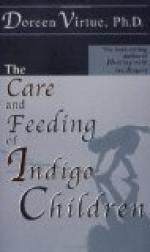In some cases the use, in place of milk sugar, of ordinary brown sugar, in half the quantity, is of assistance; or of some of the malted foods (Mellin’s food, malted milk, cereal milk) also in the place of milk sugar.
The substitution of the milk of magnesia for the lime-water as recommended on page 60 will often be found useful.
To infants over nine months old, orange juice may be given.
What special modifications are required during very hot weather?
During the warm season it is well to make the proportion of fat less than during cold weather. During short periods of excessive heat it should be much less. The fat is reduced by using 7-per-cent milk in place of 10-per-cent (i.e., the Second instead of the First Series of formulas, page 71), or plain milk in place of the 7-per-cent milk in the Second and Third Series (page 90). At such times also the usual food should be diluted, and water should be given freely between the feedings.
What changes should be made in the food of a child who, with all the signs of good digestion, gains very little or not at all in weight?
If the child seems hungry the quantity of food may be increased; but if the child will not readily take any more in quantity the strength may be increased by the use of the next higher formula. One should, however, be extremely careful under these circumstances not to coax or force a child; for this plan is almost certain to cause disturbance of digestion and actual loss in weight. A better policy is that of looking after the other factors in the child’s life,—the care, sleep, fresh air, etc., for with these rather than with the food the trouble often lies.
What should be done with infants who in spite of all variations in the milk continue to have symptoms of indigestion and do not thrive?
Except inmates of institutions who form a class by themselves, most infants who receive proper care thrive upon milk if the proportions suited to the digestion are given. Still there are some who do not. The nutrition of such is always a matter of difficulty.
If a wet-nurse is available the employment of one is the thing most likely to succeed, particularly if the infant is under four or five months old.
If the infant is older, or if a wet-nurse cannot be obtained, some of the substitutes for fresh cow’s milk may be tried. One of the best is condensed milk, Borden’s Eagle brand, canned, being preferred. This is more likely to agree if the symptoms are chiefly intestinal (colic, flatulence, curds in the stools, constipation or diarrhoea) than if they are chiefly gastric (vomiting, regurgitation, etc.).
How should condensed milk be used?
For an infant three or four months old with symptoms of indigestion, it should at first be diluted with 16 parts of boiled water, or, sometimes preferably, with barley-water. With improvement in the symptoms the dilution may be made 1 to 14, 1 to 12, 1 to 10, and 1 to 8, these changes being gradually made. The intervals between feedings and the quantities for one feeding are given on page 108.




